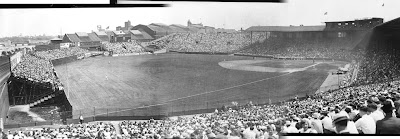The man who I think deserves the most credit for spreading the knowledge of early 20th century ballparks is Marc Okkonen. He wrote a series of Baseball Memories books in the early 1990's. His "Baseball Memories 1900-1909" had unique aerial view drawings/maps of whatever ballparks the major league teams played in during that time period. He drew these using the old fashioned method of plotting out perspective vanishing points and then laying out old fire insurance maps into that perspective grid. He then drew the buildings up from that base. For the purpose of the book, he was sure to include the angle of the midday and setting sun, knowing that was information any baseball fan would need to imagine themselves at those games. Take a look at this remarkable view of the two Boston ballparks of the day, South End Grounds and Huntington Avenue Grounds.

His books also help put things into the perspective of their time. Included are all of the newspapers of the era and the sportswriters who contributed to them. Also in each book are a couple pages describing the popular culture of the time and a mention of the peculiarities and customs of the game of that era. Oh, and they also have player, manager and owner photos galore. You know that Marc spent a LOT of time poring over all the newspapers of the era.
The only complaint one would have is a biggie, in that most of the reproductions are from photocopies, not photos of the original newspaper clippings. I would assume most of that is from the weak microfilm sources. I curse the day microfilm was adopted. Why couldn't libraries have waited 40 years until true digital technology came about before tossing their bound copies of newspapers away?
I urge anyone with an interest in these old wooden parks to pick up this book through a used bookseller. I've seen a bunch on Amazon through various used book dealers.




































